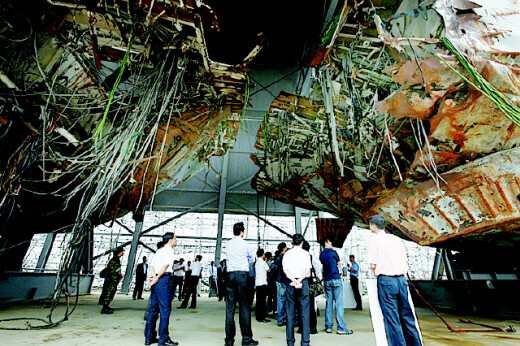hankyoreh
Links to other country sites 다른 나라 사이트 링크
“Complex combination of factors” responsible for Cheonan sinking, Russian investigation concludes

The Russian team that investigated the cause of the Cheonan's sinking concluded that a “complex combination of factors” were responsible. The report on its investigation findings essentially states that the primary problem arose while the Cheonan was sailing through deep waters, and that the underwater explosion was a secondary factor resulting from a mine.
The Russian team agreed with the South Korean joint civilian-military investigation team’s conclusion that the sinking resulting from a non-contact underwater explosion. However, in light of the state of damage to propeller screws on the Cheonan, the Russian team surmised that they had likely come into contact with the ocean floor before the explosion took place.
“Prior to the sinking, the Cheonan came into contact with the ocean floor on the right side, and there is a very strong likelihood that the propeller wings were damaged as a net became entangled with the right propeller and shaft,” the team stated.
For this reason, the Russian team said that the Cheonan was “probably limited in its sailing speed and mobility due to a net tangled in the propeller.”
As a reason for the screw becoming caught in a net, the Russian team gave the fact that the Cheonan was “sailing in shallow waters near the coast.”
In other words, the explosion occurred when the vessel’s lower part struck a mine antenna and set off its triggering device while trying to move into deeper waters.
“Indirect corroboration has been provided by the fact that there is a risk of mines in the area where damage to the vessel occurred, and that this has limited mooring and sailing locations on the West Sea coast of the Korean Peninsula,” the Russian team said.
Analysts are interpreting this as referring to the large-scale placement of depth charges by the South Korean government in the 1970s to prevent a North Korean landing on Baengnyeong Island.
Another possibility raised by the Russian investigation team was that the explosion occurred from of the South Korean military’s own torpedoes.
“There is a chance that the explosion occurred from one of the country’s own bombs as the Cheonan was sailing under conditions of malfunctioning navigation or limited mobility,” the team said.
While experts have raised a number of questions about the Russian team’s conclusions, such as the exclusion of a “North Korean-made torpedo propeller” as a cause of the explosion based on a naked-eye evaluation suggesting that it had been submerged for around six months, controversy is expected to flare up now that an investigation team sent by the Russian government has officially contradicted the “scientific and objective” investigation results announced by the South Korean team. With this, calls are expected to grow louder for an objective and transparent state investigation into the cause of the Cheonan’s sinking.
Please direct questions or comments to [englishhani@hani.co.kr]
Editorial・opinion
![[Editorial] Does Yoon think the Korean public is wrong? [Editorial] Does Yoon think the Korean public is wrong?](https://flexible.img.hani.co.kr/flexible/normal/500/300/imgdb/original/2024/0417/8517133419684774.jpg) [Editorial] Does Yoon think the Korean public is wrong?
[Editorial] Does Yoon think the Korean public is wrong?![[Editorial] As it bolsters its alliance with US, Japan must be accountable for past [Editorial] As it bolsters its alliance with US, Japan must be accountable for past](https://flexible.img.hani.co.kr/flexible/normal/500/300/imgdb/original/2024/0417/6817133413968321.jpg) [Editorial] As it bolsters its alliance with US, Japan must be accountable for past
[Editorial] As it bolsters its alliance with US, Japan must be accountable for past- [Guest essay] Amending the Constitution is Yoon’s key to leaving office in public’s good graces
- [Editorial] 10 years on, lessons of Sewol tragedy must never be forgotten
- [Column] A death blow to Korea’s prosecutor politics
- [Correspondent’s column] The US and the end of Japanese pacifism
- [Guest essay] How Korea turned its trainee doctors into monsters
- [Guest essay] As someone who helped forge Seoul-Moscow ties, their status today troubles me
- [Editorial] Koreans sent a loud and clear message to Yoon
- [Column] In Korea’s midterm elections, it’s time for accountability
Most viewed articles
- 1[Column] The clock is ticking for Korea’s first lady
- 2[News analysis] After elections, prosecutorial reform will likely make legislative agenda
- 3Samsung barricades office as unionized workers strike for better conditions
- 4[Editorial] Does Yoon think the Korean public is wrong?
- 5‘Right direction’: After judgment day from voters, Yoon shrugs off calls for change
- 6Korea, Japan jointly vow response to FX volatility as currencies tumble
- 7[Editorial] When the choice is kids or career, Korea will never overcome birth rate woes
- 8Why Israel isn’t hitting Iran with immediate retaliation
- 9S. Korea, Japan reaffirm commitment to strengthening trilateral ties with US
- 10Japan officially says compensation of Korean forced laborers isn’t its responsibility